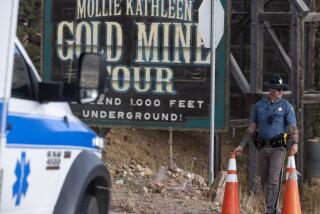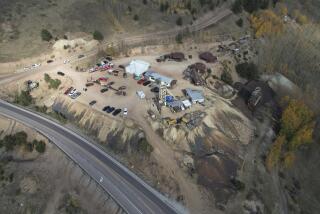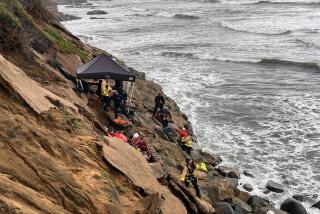Under the Ground, 9 Miners Hoped and Despaired--and Penned Farewells
QUECREEK, Pa. — They wrote goodbye letters on scraps of cardboard they had found in the mineshaft. They placed the notes in a bucket, sealed it with tape and hooked it to a piece of equipment in case rescuers were too late.
Over the next 72 hours, their hopes rose and fell like the level of the frigid water that had trapped them 240 feet beneath the Earth’s surface.
These were nine hard-bitten men who among them had spent more than a century underground, men not prone to displays of emotion. But they clung to one another for comfort and warmth, and talked tearfully about such things as the last words they had shared with their wives.
Blaine Mayhugh, the youngest of the crew at 31, winced at the thought Sunday. In 5 1/2 years of deep-mine work, he had never failed to kiss his wife before hopping in his pickup and heading off.
“I always give my wife and kids a kiss, because you never know,” he said. But on Wednesday, Leslie was mowing the lawn and Mayhugh was in a hurry. “I waved to her down in the yard and said: ‘I love you,’ ” he recalled. That hurried farewell “was one of the first things I thought of when we were trapped.”
Mayhugh and his wife kissed again early Sunday after he and his eight colleagues were hoisted out of the Quecreek Mine at the culmination of one of the most dramatic mining rescues in the nation’s history. Six of the men were released from area hospitals Sunday in remarkably good health. Only three were being kept overnight for minor treatment and observation.
Millions of Americans followed the drama as it unfolded above the surface over the last three days. But on Sunday, the miners began providing the first details of the harrowing events underground.
At times, they worked frantically, probing for possible escape routes and building makeshift walls in desperate attempts to keep the water out. At times they slumped together in despair, certain that they would not survive.
None had hesitated to enter the shaft that day when they started their eight-hour shift about 3 p.m. But several now say they will never go back.
The moment their lives changed came about 8:30 p.m., when Mark “Moe” Popernack--the crew’s operator--was making a 35-foot cut into a seam of coal. But he breached the wall of an unmapped, abandoned mine, and millions of gallons of water burst through.
“Moe hollered at me, ‘Harpo, get out of here,’ ” Dennis “Harpo” Hall, 49, said. “The water was so furious; it was so intense. You wouldn’t believe it.” Minutes after the water rushed in, Hall made his way to a telephone to warn another group of miners. “Get out,” he said. “I mean now. We’ve got major water.”
Those men who narrowly escaped credit Hall with saving their lives; they say he’s a hero. But Hall shrugs off their praise. “I was just doing my job,” he said Sunday.
The nine who were trapped worked for hours searching for a way out. They knocked down walls to open other shafts in vain attempts to lower the water level, at times so deep that they had to turn their heads to the side to keep from drowning.
Several, including Mayhugh, pressed on toward the main entrance--which required traveling downstream--but they had to stop when the rising water closed off the escape route. At times, the current seemed unconquerable.
“For a second, I said, ‘Blaine, let it go; let it take you,’ ” Mayhugh said. Then he steeled himself, saying, “Damn it, I’ve got a wife and kids. I got mad.”
He and the others dragged themselves back against the current, toward higher ground farther into the shaft, by pulling themselves along the conveyor belt that carries out the coal.
Popernack was separated from the rest of the group for the first several hours. It was the crew boss, Randy Fogle, 48, who found Popernack and brought him back.
At one point, 52-year-old Tommy Foy, the crew mechanic and Mayhugh’s father-in-law, bound the group together with a metal cord looped through their belts so that if the water kept rising and they died, they wouldn’t float away from one another.
The men spent several hours searching for a haven. By early Thursday, they had made their way to what was essentially a subterranean beach, a 40-by-20-foot area where the soil was soggy but there was no standing water.
Fogle directed the men to build barricade walls out of cinderblocks they had found in the mine to help keep the water out. “We worked frantically to build the walls,” Hall said. “It was to keep the water off us as long as we could until we could be rescued.”
The men got their first glimmer of hope that a rescue might be imminent when crews on the surface punched a 6-inch shaft down into an air pocket near where they were waiting. The miners rushed to the pipe and struck it with a hammer nine times--nine clangs that resonated to the surface, signaling that all the men were alive and boosting the spirits of their loved ones.
Soon after that, maybe an hour, the water came up again and the miners had to head to higher ground, Mayhugh said. For the next few days, they would repeatedly try to send signals--pounding on a metal plate holding up the soil over their heads--but none of that was heard on the surface.
The miners could hear the enormous drill burrowing toward them from above, but their spirits sagged with every pause--particularly Friday, when drilling stopped for about 18 hours because the 30-inch bit broke and rescuers had trouble fishing it out of the shaft.
“We thought maybe they couldn’t find us, or maybe they just broke down,” Mayhugh said. “We didn’t know what to think.”
Friday’s delay was also a low point for family members, who spent the bulk of the three-day ordeal at a nearby fire station, hanging on every update from the rescue operation.
“I kind of lost my faith and started thinking my son is not coming home,” said Margie Mayhugh, Blaine’s mother. Margie said she never approved of her son working in the deep mines, and forbade him from so much as mentioning it in her presence.
But Mayhugh had taken the job because it paid well. “For this area, the money’s good,” he said. “I wanted my kids to have stuff. Around here, you’re talking $7 an hour [for most jobs]; it’s $15 an hour underground.”
When they got news of the accident Wednesday, Mayhugh’s parents feared the worst. When his pickup was retrieved from the mine site and parked at the fire station, Mayhugh’s father, also named Blaine, rubbed its paint gently as if it were his son’s face. Mayhugh’s sister Pam opened the lunchbox inside the cab to see whether her brother had eaten the day of the accident--he had. But Margie wouldn’t go near the truck.
Meanwhile, one of the biggest challenges underground was keeping warm. The miners, coughing in the stale air, sought out the highest ground they could find and then huddled together, side-by-side and back-to-back.
“Anything to produce body heat,” Mayhugh said.
In the first hours, the miners had grabbed a case of water, about six gallons, so they did not have to drink the water flowing through the mine, which was full of coal dust. They had no food, except some Lifesavers and a single sandwich, which they shared.
Several of the men lost their tins of chewing tobacco in the water, so by early Thursday, they ran out. “Local miners like to chew snuff underground,” Hall said. “There was a major shortage. It wasn’t funny to us. It put nerves on end.”
The men spent much of their ordeal in complete darkness, preserving two functioning headlights for the hoped-for rescue. They also paid close attention to the drone of the rescue effort above, and would periodically dispatch a two-man team to trudge through the water to a cavity a few hundred feet away where the drill was descending. About 10 p.m. Saturday, Foy and another miner, Ron Hileman, shouted back to the rest of the crew that the drill had finally burst through.
The other seven men rushed to what would become their escape shaft and shouted wildly. Shortly thereafter, they heard clear signals on the nearby air tube. Hileman, 49, beat on it in reply, and then the pipe disappeared. Just before 11 p.m., a microphone and a neon green light came down in its place.
John “Flathead” Phillipi, the miner who sent the first message to the surface, took the opportunity to ask for some snuff. Shortly before 1 a.m. Sunday, the rescue capsule--filled with blankets, jackets, water and snuff--arrived.
“It was a lovely sight,” Hall said with a smile Sunday. “Everybody wanted to get in at once. But there was only room for one.”
Fogle, who was suffering from chest pain, would go first. Mayhugh was second. Hall was the seventh man to reach the surface, about 2:20 a.m. Shortly after, they had all been pulled from the mine.
The letters they had written in the first hours of the ordeal were left behind.
The men were taken to two hospitals, where they were reunited with their families. Mayhugh embraced his wife and said his first words to her were: “It’s a miracle. I’ll never go back in again.” Leslie’s father, Tommy Foy--who has a history of heart trouble and ulcers--was kept overnight at the hospital, where he made a similar pledge to his daughter.
But for other members of the crew, the mines already beckon. Just hours after the trauma was over, Hall said he was already preparing to go back.
“Truthfully, I don’t cherish the fact of going back,” Hall said. “But I’ve been doing it 30 years. It’s in my blood. I have a family to take care of. You do what you have to do.”
*
(BEGIN TEXT OF INFOBOX)
*
Countdown to a Mine Rescue
A chronology of events in the mining accident near Somerset, Pa. (times Eastern):
*
Wednesday: Trapped and Flooded
9 p.m. Nine miners become trapped after breaking into an adjacent, abandoned mine. The Quecreek mine is flooded with 50 million to 60 million gallons of water.
*
Thursday: Rescuers Hear Tapping
3:30 a.m. Rescue workers hear tapping from area where the miners are trapped.
2:30 p.m. A large drill rig arrives from a West Virginia mine.
6 p.m. Crews begin drilling tunnel to reach miners.
*
Friday: Drilling Stops When Bit Breaks
2 a.m. Drill bit gets stuck 100 feet down and breaks.
11:10 a.m. Digging with new equipment begins on another shaft about 75 feet from the first.
4:45 p.m. Broken bit is removed from first tunnel.
8 p.m. Drilling resumes on first rescue shaft.
*
Saturday: “We’re on the Verge”
3 p.m. Tunnel reaches within 20 feet from chamber where miners are trapped.
7:30 p.m. Gov. Mark Schweiker announces, “We’re on the verge.”
8 p.m. Drilling in first rescue shaft stopped briefly at 227 feet to fix problem with compressed air drill.
10:20 p.m. Drill in first rescue shaft breaks through into mine chamber 240 feet underground; workers remove equipment used to pump compressed air into the chamber and begin to tap on pipes, listening for response.
10:50 p.m. A line of rescue workers lowers a telephone and green light into smaller shaft next to drilling site.
11:35 p.m. Public told all nine
miners are alive.
*
Sunday: All Nine Pulled From Tunnel
1 a.m. First miner pulled from
the rescue shaft.
2:45 a.m. All nine miners pulled out alive.
*
Source: Times wire and staff reports
More to Read
Sign up for Essential California
The most important California stories and recommendations in your inbox every morning.
You may occasionally receive promotional content from the Los Angeles Times.










